|
[Front Page] [Features] [Departments] [Society Home] [Subscribe]

Short Cuts
Short items of interest about Australian plants selected from the many newsletters and journals published by member Societies of ASGAP.......
Short Cuts in this issue:
 What's a karkella? What's a karkella?- A colourful dune plant of southern Australia, that's what!
 Outwitting the Local Kangaroos Outwitting the Local Kangaroos- Nothing is more inviting to a kangaroo than fresh green foliage!
 Smoked Vermiculite Smoked Vermiculite- A novel method of assisting seed germination
 A Spectacular Persoonia A Spectacular Persoonia- Growing the beautiful pine-leaved geebung
 What's Behind that Name?? What's Behind that Name??- Botanical names needn't be intimidating....really!!
 Unlocking the Secrets of Flannel Flowers Unlocking the Secrets of Flannel Flowers- Many have tried but success is fleeting in the cultivation of flannel flowers

What's a Karkella?
More commonly known as "pigface", members of the genus Carpobrotus are common on coastal dunes. Bill Gunn discusses a common species found all along Australia's southern coast.
The genus Carpobrotus is a member of the family Aizoaceae. In Australia there are four indigenous members, one of which is C.rossii, named after William Ross, the collector. Karkella is this plant's Koori name. It is usually found in sandy, coastal situations, in full or part sun.
Karkella is a spreading, succulent perennial flowering from spring to late summer. The main stems are slender and prostrate. The short stems which support the flowers are erect. The flowers, which are quite spectacular, are 4 or 5 cms across with pale purple 'petals' becoming, white at their base. After flowering, globular fruit which is purple/red and about 2 cms in diameter is produced. The fruit is edible and was enjoyed by indigenous people. The leaves are fleshy and up to 8 cms long by 1 cm wide.
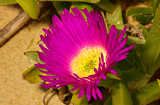 |
The 'petals' of Carpobrotus rossii are actually staminodes which are sterile stamens)
Select the thumbnail image or highlighted name for a higher resolution image (39k).
|
The brilliant flowers and the prostrate nature of Karkella make it very attractive as a rockery plant or on a slope. Propagation is from seed or cuttings or from stems which have layered themselves.
From Growing Australian, newsletter of the Australian Plants Society (Vic), March 1999.
[ Return to Index
]

Outwitting the Local Kangaroos
National emblem or not, kangaroos can make plant establishment a challenge! Brian Fopp outlines his experiments at deterring our native nibblers
As a topic for informed discussion, kangaroos present problems. Even for people who think that they know a lot about these animals, it is not easy to get things right. Wendy and I were made aware of this when we visited a Conservation Society Shop in San Francisco. Following one of our yearly culling episodes, a pamphlet in the shop castigated Australians for their "wholesale slaughter of their national emblem". The writers really had no idea of the problems that large numbers of kangaroos can cause. However, they knew what they had been told and they would not be convinced otherwise!
 
At home here in Willunga, we also have problems with kangaroos. Our difficulties are strictly practical. It is very disappointing to plant out 100 tube stock one weekend only to find that, a few days later, after a visit by the local kangaroos, nothing is left. When the pasture and grasses are dry, the green shoots of our young plants are obviously succulent and sought after. Sometimes we despair! We would dearly love to know how to deter the nibblings of our national emblem!
On the 100 hectares of property that is shared between three neighbours, there are about 60 hectares of near virgin scrub which is (or was until about a year ago) home for about 40 kangaroos. These have tended to cull themselves, their numbers varying with the seasons. Last year was obviously an excellent year for kangaroo breeding; we witnessed numerous pairs which were cavorting down hillsides, and whose love activities flattened our young trees. On the assumption that half of the 'roos were females, I consider that another 20 animals have joined the group. This is being borne out by the quantity of leaf consumption.
Since we began our planting at Uralba we have tried several methods of kangaroo deterrence. We have a State permit to cull the animals ourselves, but we don't like the idea, so we are persevering with other means.
- We purchased 400 conical GroCone seedling protectors from Sydney. GroCone protectors are made from UV-stabilised recycled plastic. The cone is secured in the ground by three 19 cm long metal anchor legs. Depending on exposure at the site, the cones are supposed to last from 2-5 years. The cones are 60 cm high. The base has a 20 cm diameter, and the cone tapers to a 10 cm opening at the top.
The GroCones were excellent as the top of the tube was too narrow for a large 'roo nose. However, they were not perfect, as they were not too narrow for youngsters' noses - the emergence of the plant through the top of the cone invited eating and some plants tended to grow around in circles inside the cones.
GroCone protectors are now available from Agvance Rural Services, PO Box 45, Saddleworth, 5413.
- We obtained some experimental wallaby repellent from the Department of Natural Resources and Environment (DNRE) in Victoria. This was not cheap ($200 for the first year's supply) but it is effective if it is earnestly applied to young plants. A nibbling 'roo obviously detests the taste and spits it out. Unfortunately, 'roo communication is poor. After 40-odd tastes, not much of a young plant is left.
The repellent is available from Michael Johnston, Research Assistant, Browsing Repellent Project, Vertebrate Pest Research Department, Victorian Institute of Animal Science. Tel: 03 9785 0111, Fax: 03 9785 2007. We won't be getting more.
- In Small Talk, May/June 1998, published by the Land Management Programme, I found the following interesting recipe, which had, in turn, been extracted from another source (July 1997 newsletter of Permaculture West). We are about to try it as our DNRE wallaby repellent is almost exhausted.
The recipe: Beat together 5 eggs mixed with 600 ml water and 150 ml acrylic paint.
Margaret Leslie, in a Land Management Society newsletter (April 1998), reports that 300 Tasmanian blackwood trees on which they painted this mixture have never again been touched by kangaroos. The trees continue to flourish. This mixture is somewhat like the Victorian wallaby repellent in that it has the most obnoxious smell when it is a few weeks old. It is also about as successful. We decided that the answer could be in a deterrent prior to nibbling!
- Late last year and earlier this year, we put Vick's Vapour Rub onto the upper surface of leaves of plants that were being consumed by possums. It worked well. We intend to try it with the kangaroos.
- . We also tried pouring a ring of creosote around individual plants. That idea works for rabbits and small 'roos - but it does not seem to deter the 'higher noses' of large kangaroos.
PS. October 1999: our first trials of Vick's (the cheap version from Coles) appears to be successful.
From the newsletter of the Australian Plants Society, South Australia, February 2000.
[ Return to Index
]

Smoked Vermiculite
Warren and Gloria Sheather suggest a novel method for smoke-assisted germination of seeds of Australian native plants.
We all know of the benefits of smoke to improve germination of many native plant seeds. The usual method of seed treatment is to soak them in smoked water. There is another method of seed treatment which may be of interest. Seeds are sown in the usual method and then covered by a layer of vermiculite which has been impregnated with smoke.
In theory, as the seed pots are watered, the chemicals in the smoke are carried through to the seeds and work their germination magic.
Smoked vermiculite is easier to produce than smoked water. We build a fire in the incinerator and cover with sawdust so a smoky fire results with no flame. Moistened vermiculite is spread in a fine sieve and placed on a metal frame above the smoke. It is left there for about 20 minutes. The smoked vermiculite is then stored in a sealed plastic bag until required.
We are experimenting with this material and will communicate our results in a later newsletter.
From Native Plants for New South Wales, newsletter of the Australian Plants Society (NSW), January 2000 issue.
[ Return to Index
]

A Spectacular Persoonia
It may be difficult to propagate but it's becoming more readily available. Norm McCarthy reckons you should give the pine-leaved geebung a go!
The genus Persoonia is a part of the large family of Proteaceae and boasts some 55 species. Persoonia pinifolia, the pine-leaved geebung, is probably the showiest of all.
The common name 'geebung' is derived from an aboriginal term 'jibbong' to describe the fruit of the Persoonia species. Aborigines ate the fruit of some selected species while the fruits of other species were used medicinally. However, due care should be taken and the fruit not eaten at all because of the poisonous content of cyanide existing in many species.
P.pinifolia can grow to 3 metres by 3 metres in well drained mostly sandstone or similar soils in dry sclerophyll forests. In its natural habitat it is restricted to an area in New South Wales bounded by Broken Bay in the north, the Royal National Park south of Sydney and by the lower slopes of the Blue Mountains to the west.
 |
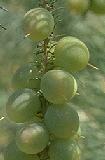 |
Pine-leaved geebung:
Flowers (left) and fruit (right).
Select the thumbnail image or highlighted name for a higher resolution image (40k and 29k).
|
This particular species of Persoonia is an erect shrub and has a slightly rough brownish grey stem with brownish branches. The bright green leaves are crowded on the stems and flattish nearly terete with a shallow groove above. The leaves are almost sessile on the stems and may measure 3 to 7 cm long by 5 mm wide. The plant is inclined to adopt a slightly pendulous habit on maturity.
Flowers, bright yellow and fragrant, occur in terminal conical racemes about 10 cm long. Flowering generally occurs during the summer months and can persist for long periods. The tree in full bloom becomes a garden showcase.
The fruits are sub globose, green to brownish in clusters with persistent styles.
P.pinifolia prefers an annual rainfall of 500 mm to 1500 mm with good drainage. Like most proteaceous plants it resents disturbance. With these prerequisites, this highly ornamental shrub may be grown well far from its local habitat. My plant excels in a sandbed at 700 metres in Toowoomba, southeast Queensland.
Propagation is most difficult from seed. Soft tip cuttings taken in January or February may yield moderately good results.
From Native Plants for New South Wales, newsletter of the Australian Plants Society (NSW), April 2000 issue.
[ Return to Index
]

What's Behind that Name??
Klaus Engelhard* explains how botanical names are derived - and concludes that they needn't be as intimidating as many people believe.
The most common complaint heard from new members of the Australian Plants Society goes something like this: "Why do they have to use those horrible names!, Why not use names that normal people can understand?"
On first impressions this seems quite a legitimate plea. Why can't we make up our own names for plants and base them on what plants are used for or on their appearance? That way we can have "Bottlebrush", "Spider flower" or "Blue gum" and every one would be happy.....or would they?
There is really only one solution - if you want to be able to read about or talk about plants you must sooner or later learn about their proper or scientific names.
The method of naming plants is credited to Carl von Linne, a Swedish scientist and botanist who become Professor of Botany at the University of Uppsala in 1742. He became famous as Carolus Linnaeus because he wrote all his books in Latin.
One of the advantages of Latin is that it is a dead language and therefore static unlike current languages which constantly change to suit everyday use. If you think that this change is minor, try reading Chaucer's Canterbury Tales in its original version!
Under the Linnaeus system, each living thing has a name in two parts. The first is for genus, the second is tor the species. This is a bit like family names and given names. There may he several people called Johnson in a group of people but only one Fred. It is the same with plants: there are many species of Grevillea but only one of them is called johnsonii.
A little understanding of Latin and ancient Greek goes a long was in solving the mystery of why a plant finished up with a particular name. See if you can work out the code by using this key:
| Genus name | Derivation |
| Banksia | Named after Joseph Banks (later Sir) who accompanied Captain Cook from 1768-71. |
| Grevillea | Named in honour of Charles Francis Greville - one of the founders of the Horticulture Society. |
| Eucalyptus | From the Greek eu meaning well and calyptos meaning covered. It refers to the cap which covers the stamens in bud. |
Examples of terms used to name plant species: |
| brachy - short | robusta - strong | meli - honey |
| di - two | citri - lemon | tri- three |
| odora - scented | tetra - four | bunda - lots of |
| flos - flower | leucos - white | ilic - holly like |
| sperma - seed | quercus - oak like | leptos - thin |
| serra - a saw | carpos - fruit | latus - broad |
| foli - leaf | pachy - thick | phyll - a leaf |
Now you may be able to see how the following plants were given their names:
Eucalyptus pachyphylla, Eucalyptus tetraptera, Grevillea robusta, Grevillea floribunda, Banksia ilicifolia, Banksia serrata. See. It's not all that difficult?
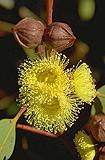 |
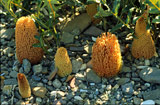 |
|
Eucalyptus pachyphylla (left) gets its name from its thick leaves while Banksia repens (right) has a creeping (prostrate) growth habit.
Select the thumbnail image or plant names for higher resolution images (30k and 39k).
|
Other examples of this latinization include: Banks (Banksia), Caley (caleyi), Cunningham (cunninghamii) etc thus leading to names such as Banksia menziesii (named after Archibald Menzies, surgeon naturalist on the Discovery expedition) or Banksia caleyi. The latter combines the names of one of Australia's least recognised explorer/botantist with that of his patron.
Scientific names need not be confusing but it takes a little time to get used to them and to understand their meaning. Sit down and try to break the code, it will be worth it in the end.
From "Calgaroo", the newsletter of the Parramatta and Hills District Group of the Australian Plants Society, May 1989.
* Klaus Engelhard passed away in early 2000 and is greatly missed by his many friends in the Society.
[ Return to Index
]

Unlocking the Secrets of Flannel Flowers
Paul Davies reports on work being carried out at Mt Annan Botanic Gardens to understand the mysteries of flannel flower cultivation.
Without doubt, flannel flowers, like other gems such as Christmas bells and waratahs, must be one of the most beautiful and desirable plants found on the Hawkesbury sandstone. To come across a patch of them in flower, growing in half an inch of soil on a sandstone outcrop, is one of the real treats of bushwalking in Sydney.
However, those of us who have attempted to grow them in our gardens know that flannel flowers bear out the second law of native plant gardening (i.e. that a plant's desirability is inversely proportional to its likelihood of surviving in your garden). It is therefore comforting to know that there are researchers, such as Lynette Lee from Mt Annan Botanic Garden, who are doing their level best to find out how these plants grow, survive and reproduce.
Flannel flowers (Actinotus helianthi) belong to the Apiaceae family, which includes our old culinary stand-bys such as carrots, celery and parsnip. There are 15 species of Actinotus worldwide (14 in Australia, 1 in New Zealand).
The flowering head of the flannel flower comprises an umbel containing a cluster of small flowers called florets. Each umbel contains a mixture of perfect (hemaphroditic) flowers and male (staminate) flowers. The first umbel to develop is called the primary umbel. Branching off this are secondary umbels, followed by further branching into tertiary umbels. This pattern of urnbel development promotes cross-pollination and minimizes self-pollination. The structure of the flower head can vary considerably from area to area. In some, the bracts are broad and overlapping, whilst in others the bracts are narrow and well separated.
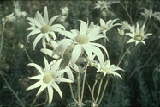 |
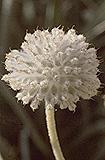 |
|
The daisy-like "flowers" of Actinotus helianthi (left) are really clusters of small flowers surrounded by petal-like bracts. The seeds (right) develop in a globular head and are dispersed by the breeze.
Select the thumbnail image or plant names for higher resolution images (24k and 28k).
|
Flannel flowers are found in sandy, rocky places in woodland and open forest, from southern New South Wales to Queensland. They usually grow up to one metre in height, but can reach 1.5 metres. Flannel flowers are considered pioneer species, and usually live from four to five years. They occur in abundance after bushfires, when competition from other plants is minimal.
Once the flower head is fertilised, the bracts are lost and the seeds develop and disperse. Seed dormancy is seen in flannel flowers, and is considered to be a mechanism to ensure that the seeds germinate at the most favourable time. About 30% of flannel flower seeds lack an embryo (inviable seeds). Temperature affects germination, with seeds reaching maximum germination in temperatures of 15-20 degrees Celsius. Lynette has also found that dry storage of seed improves germination and she suggests storing the seed for a few months before sowing. When collecting seed for propagation, Lynette recommends waiting until the seed head changes colour from green to brown. The highest percentage of germination Lynette has achieved is 80%, but 40% to 50% is more tvpical.
To grow flannel flowers in pots, use two parts sand to one part peat. Flannel flowers enjoy some fertilizer, so a little slow release fertilizer will help. When planting in the garden, select a sunny site with sandy soil and good drainage. Whilst this isn't a guarantee for success, at least you'll feel yoiu've done everything possible!
From the August 1995 issue of Blandfordia, newsletter of the North Shore Group of the Australian Plants Society (NSW).
[ Return to Index
]

[Front Page] [Features] [Departments] [Society Home] [Subscribe]
Australian Plants online - June 2001
Association of Societies for Growing Australian Plants
|